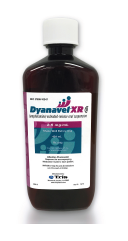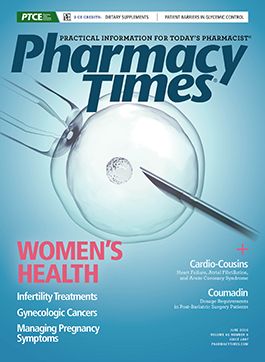
Dyanavel XR
Dyanavel XR extended-release oral suspension has received FDA approval for the treatment of ADHD in patients 6 years and older.

Dyanavel XR (amphetamine) extended-release oral suspension, a class II drug, has received FDA approval for the treatment of attention- deficient/hyperactivity disorder (ADHD) in patients 6 years and older. Dyanavel XR uses a patented delivery system consisting of immediate- release and extended-release amphetamine and is the only once-daily, extended-release, amphetamine- based oral liquid approved to treat ADHD in children.1,2
PHARMACOLOGY AND PHARMACOKINETICS
The mechanism of action of amphetamines in the treatment of ADHD is not known; however, they are believed to block the reuptake of norepinephrine and dopamine into presynaptic neurons and increase the release of these monoamines into the extraneuronal space.1
Dyanavel XR consists of d-amphetamine and l-amphetamine in a ratio of 3.2:1. A single 18.8- mg dose of Dyanavel XR in healthy adult patients demonstrated an elimination half-life of approximately 12 hours for d-amphetamine and 15 hours for l-amphetamine.1 The LiquiXR technology uses ion exchange polymeric chemistry to deliver a continuous release of amphetamine throughout the day.2
DOSAGE AND ADMINISTRATION
For children 6 years and older, treatment with Dyanavel XR should be initiated at 2.5 or 5 mg by mouth once daily in the morning. The dose may be increased in increments of 2.5 to 10 mg per day every 4 to 7 days until optimal response is obtained, with a maximum daily dose of 20 mg per day. Dyanavel XR contains 2.5 mg of amphetamine base per milliliter.
Prior to administration of Dyanavel XR, the bottle should be shaken. Dyanavel XR may be given with or without food. Dyanavel XR should not be substituted for other amphetamine products on a milligram-per-milligram basis due to differences in amphetamine base compositions and pharmacokinetic profiles.1
CLINICAL TRIALS
The efficacy of Dyanavel XR was evaluated in a laboratory classroom study of 108 pediatric patients aged 6 to 12 years with ADHD. The study began a 5-week, open-label, dose-optimization trial. Patients then underwent a 1-week randomized, double-blind treatment with the individually optimized dose of Dyanavel XR or placebo. At the week’s end, school teachers and raters evaluated the attention and behavior of the patients in the laboratory classroom. The primary end point was the change from pre-dose in the Swanson, Kotkin, Agler, M-Flynn, and Pelham (SKAMP)-combined score at 4 hours after dosing. The SKAMP-combined change scores from pre-dose showed a statistically significant improvement at all time points after dosing with Dyanavel XR compared with placebo. Key secondary end points were also met by demonstrating an onset of effect at 1 hour that lasted through 13 hours after dose, compared with placebo.1,2
CONTRAINDICATIONS, WARNINGS, AND PRECAUTIONS
Dyanavel XR carries a boxed warning regarding the high potential for abuse of and dependence on central nervous system (CNS) stimulants, including Dyanavel XR. The warning also states that risk of abuse should be assessed prior to prescribing Dyanavel XR and that patients using the medication should be monitored for signs of abuse and dependency during treatment.
Dyanavel XR is contraindicated in patients with a known hypersensitivity to amphetamine products or any other components of the product, and in patients using or within 14 days of the last dose of a monoamine oxidase inhibitor. Treatment with Dyanavel XR also should be avoided in patients with structural cardiac abnormalities, cardiomyopathy, serious heart arrhythmias, or coronary artery disease. CNS stimulants increase blood pressure and heart rate; therefore, patients should be monitored accordingly.
Use of CNS stimulants may cause psychotic or manic symptoms in patients with no history of either or exacerbation of symptoms in patients with preexisting psychosis. Patients should be evaluated for bipolar disorder prior to beginning treatment with stimulants. Because CNS stimulant use has been associated with growth suppression, height and weight should be monitored in pediatric patients during therapy. Peripheral vasculopathy, including Raynaud’s phenomenon, has been associated with CNS stimulant use.
Substances that alter urinary pH can alter serum levels of amphetamines. Acidifying agents can decrease amphetamine levels, whereas alkalinizing agents can increase amphetamine levels. Use of Dyanavel XR during pregnancy may cause fetal harm. It also should not be used during breast-feeding.
The most common adverse reactions are dry mouth, anorexia, weight loss, abdominal pain, nausea, insomnia, restlessness, emotional lability, dizziness, and tachycardia.1
Dr. Holmberg earned her PharmD from the University of Connecticut and completed an ambulatory care residency at the Phoenix VA Healthcare System. Her practice has also included pediatrics and inpatient mental health. She resides in Phoenix, Arizona.
References
- Dyanavel XR [package insert]. Monmouth Junction, NJ: Tris Pharma; 2015.
- Tris Pharma receives FDA approval of Dyanavel XR (amphetamine) CII as once-daily liquid for treatment of ADHD in Children [news release]. Monmouth Junction, NJ: Tris Pharma; October 20, 2015. trispharma.com/news_dyan2015.php. Accessed February 2016.

2 Commerce Drive
Cranbury, NJ 08512
All rights reserved.